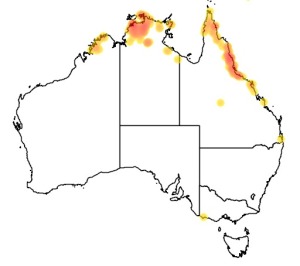Colours
Distinguishing features
Both sexes have relatively small heads compared to their body and tail, but the heads of the male are flatter and broader than those of the female.
The forehead, neck, back, and upper wings of the adults owls are usually a dark reddish-brown color with light brown barring scattered throughout. The face is dark brown, and the neck, breast and under part is rufous colored with thin cream colored bars. The underside of the wings are light brown with thick cream bars. Its hooked bill is light gray and is surrounded by black bristles at its base. It has golden-yellow eyes. (Wikipedia)
Size
- Up to 46 cm (Length of specimen) - applies to Females
- Up to 55 cm (Length of specimen) - applies to Males
Wingspan
- From 100 cm to 120 cm
Synonyms
Distribution
Distribution and habitat preferences
It has a wide geographic range. It is native to Australia, Indonesia, and Papua New Guinea. In Australia, it is found in the following regions: Arnhem Land, the northern Kimberleys, the eastern Cape York Peninsula, and the Mackay District of eastern Queensland. It is the only exclusively tropical owl in Australia.
It most often lives in rainforests and the margins of rainforests. Additional habitats may include forests, moist savannas, and inland wetlands. (Wikipedia)
Chronotypes
Diet
It is a skilled and powerful hunter, capable of capturing a wide variety of prey. Their diet is extremely diverse, ranging from birds and insects to small mammals such as possums, gliders and flying foxes. ��Typically, it will hunt the juveniles of the larger mammal prey species. They also take birds.
They have been observed to utilize several hunting methods. They may take prey from perches, snatch from tree foliage while in flight, chase while in flight, or swoop from the air and catch their prey from the ground or water below. (Wikipedia)


